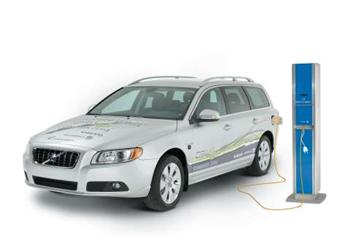|
Home | News | Road Tests | ||||||||||||
Volvo Cars To Try Plug-in Hybrid Technology
Volvo Cars continues to focus on advanced eco-friendly technology and is now taking yet another step forward in keeping with the company's vision - DRIVe Towards Zero. A joint project with Swedish energy supplier Vattenfall will see the production of battery-powered Volvos featuring plug-in hybrid technology as early as 2012. "There is no doubt that the environmental issue is at the very top of Volvo Cars' product development agenda right now," says Stephen Odell, President and CEO of Volvo Cars. "Carbon dioxide emissions from our cars will be drastically reduced by the plan we are now implementing and our aggressive electrification strategy will put us in a leading position when it comes to environmentally optimised passenger transport." Plug-in electrical hybrids in production by 2012 There are many benefits to plug-in electrical hybrids: carbon dioxide emissions are far lower and with an electric motor offering higher power, the car's performance is also far better. Being able to offer a truly attractive car that does not compromise on the other important properties that the customer wants is an absolute precondition for the market to shift towards more environmentally sustainable alternatives that really do make a difference. "In fact, I would go so far as to say that the plug-in electrical hybrid we will launch in 2012 will be a true dream car. With the innovative solution we will offer, the car owner will be able to drive a thoroughly enjoyable car packed with Volvo's renowned high safety and genuine driving pleasure", says Stephen Odell. Stephen Odell says that Volvo Cars' industrial cooperation with Vattenfall opens up entirely new potential for developing future eco-friendly technologies in a far more efficient way. Working in partnership is something that the company regards as essential in order to generate sustainable development. "DRIVe Towards Zero is our vision and with Vattenfall's expertise and partnership, we are making giant strides towards our targets. With our updated environmental map for the future, we are reinforcing our leading position in the environmental sphere within the premium segment," concludes Stephen Odell. The following section presents Volvo Cars' environmental alternative and its map for the future: DRIVe At present, Volvo Cars has seven car models that can be specified in DRIVe configuration. The DRIVe badge is attached to those cars in the model range that have extremely low carbon dioxide emissions. Among their many features, these cars have been specially designed for low air resistance and their drivelines are optimised for low fuel consumption. The most fuel-efficient variants are the C30, S40 and V50 1.6D DRIVe, with fuel consumption of 3.9 litres/100 km (104 grammes CO2/km).
FlexiFuel Volvo Cars' FlexiFuel models are powered by E85 (85 per cent renewable bioethanol and 15 per cent petrol). Bioethanol is an entirely renewable fuel and can be made from a variety of sources such as sugar cane, wheat and wood by-products. Both Volvo's smaller models (the C30, S40 and V50) and the larger cars (the V70 and S80) are available in FlexiFuel variants. There is a choice of three engine power outputs: the 1.8F producing 125 hp, the 2.0F which produces 145 hp and the turbocharged version, the 231 hp 2.5FT. Bi-Fuel: V70 2.5FT in gas configuration Biogas is one of the vehicle fuels with the lowest climate impact. On Volvo Cars' home market, where there is a satisfactory infrastructure for gas supply, the V70 model will be available in a gas-powered version in 2009. An outside conversion specialist contracted by Volvo Cars will fit the gas tank. The car's range on gas is about 300 kms. To back this up there is the 2.5FT 231 hp FlexiFuel engine so the car's total range on biofuel is more than 900 kms. The car can be run on petrol, bioethanol, natural gas, biogas and hytane*. * Methane gas with 10 per cent hydrogen gas mixed in the fuel. Start/Stop The Volvo Cars model range also includes engines that switch themselves off when the car comes to a standstill. These so-called micro-hybrids cut fuel consumption by 4-5 per cent. This system is even more effective in congested city traffic with frequent stopping and starting. Start/Stop is being initially introduced on the C30, S40 and V50 DRIVe and will undergo constant development, and will over time be implemented in additional drivelines. In 2011, Volvo Cars expects to introduce yet another highly advanced, entirely in-house developed system with even greater savings potential. GTDi technology Later in 2009, Volvo Cars will launch the development of an entirely new generation of high-efficiency petrol engines. These engines will be far more economical and will cut fuel consumption and carbon dioxide emissions by 20-30 per cent. GTDi technology makes it possible to reduce engine size while retaining current performance levels. Plug-in electrical hybrids Volvo Cars will put plug-in electrical hybrids on the market as early as 2012. With this technology, there is a battery pack that is used to drive an entirely emission-free electric motor. The battery is recharged via a regular wall socket and, in addition, braking energy while on the move is stored and reused. This power system will be supplemented by one of Volvo's high-efficiency diesel engines. This diesel engine is designed to run on renewable synthetic diesel and will meet forthcoming extremely stringent exhaust regulations. The car's range will be class-leading and what is more, tailpipe exhaust emissions will be virtually non-existent while the car is powered by electricity. If the battery pack is recharged with electricity produced from renewable sources, then carbon dioxide emissions from the lifecycle perspective will also be very low. In the NEDC standardised driving cycle, carbon dioxide emissions from Volvo's plug-in electrical hybrid will be lower than 50 grammes/km. The plug-in electrical hybrid will thus qualify into what is known as the super-credit tax incentive band. In several European countries, a variety of incentive programmes such as tax relief will be introduced over the next few years. Cars that emit less than 50 grams of CO2/km will probably be granted the most favourable status. Battery-powered cars For short distances in city traffic, dedicated battery-powered cars may well be the next step. Volvo Cars is therefore researching this aspect. There are still many challenges that have to be solved with battery cars and the company is working hard to find alternative ways of reducing battery cost, increasing their performance and ensuring that Volvo's safety requirements are met at all times. At present, there are no battery-powered cars in Volvo's product plans, but the possibility of introducing new eco-friendly technology is under constant review. | ||||||||||||
More Volvo News .....
here
About | Car Clubs | Home | News | Road Ramblings | Road Tests | Subscribe | Top Drive © 2009 All rights reserved. Next Car Pty. Ltd. |




